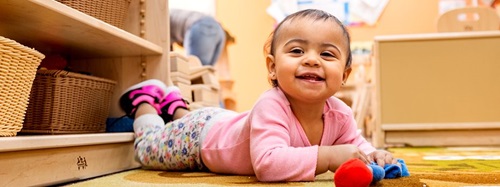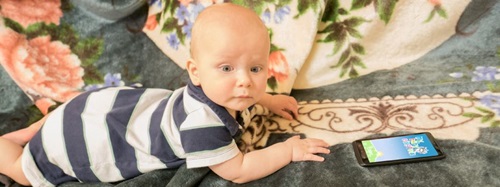Creating Nurturing Relationships with Infants and Toddlers
| July 2025For infants and toddlers to prosper in group care, caregivers have to form sensitive and responsive relationships with each child. Such relationships are important to children of all ages but particularly so to infants and toddlers. A caregiver’s sensitivity and responsiveness strongly influence how each child in their care will act towards and feel about the other people around them. If the caregiver is reasonably responsive to the baby’s message—when the baby cries, they come; when the baby acts shyly, they do not force the baby to make contact—the caregiver can give a positive tint to the lens through which the child looks at life.
A caregiver’s responsive behavior has the following effects:
- The child learns at a young age that they can have an effect on the outside world and can make things happen.
- The child is encouraged to send more messages, to keep reaching out. The child will use and sharpen their communication skills because the child learns that communication works.
- The child builds self-esteem, learning “I am someone who is paid attention to—I am worthy.”
- The child’s feelings of security, trust, and confidence in the world are nurtured.
Caregivers can learn to be more responsive by getting in the habit of following a three-step responsive process. These three steps blend into a natural “dance” that both the child and caregiver enjoy.
The Responsive Process
The three steps in the responsive process are watch, ask, and adapt.
Step One: Watch
The caregiver begins interactions with an infant or toddler by simply watching the child. By watching first and not just rushing to do things for the baby, a caregiver can avoid the mistake of reacting before receiving the full message from the child. The caregiver looks with both eyes, listens with both ears, and gives the child time to get a message across. The caregiver watches for both verbal and nonverbal messages.
The caregiver watches how babies curl their toes, arch their backs, widen their eyes, wave their arms, and grow quiet. With older children, the caregiver watches their many gestures.
For example, if children tug at their hair, sit apart from other children, or lie curled toward the wall, they are probably experiencing fear. Adults will be surprised at how much they can learn by watching.
In daily contacts with an infant or toddler, caregivers need to remember that they must be willing to choose the role of learner for part of the time. Only by first learning what the infant or toddler is calling for can a caregiver choose the right response. Being a learner means spending a lot of time observing, “reading” the child, figuring out what message they are sending—not only the sounds and words but also the facial expressions, hand gestures, and other body language. Sometimes learning means getting right on the floor with the child and seeing things as the child sees them.
By observing the child, caregivers will see things that require immediate attention, such as signs of physical discomfort or hunger. Caregivers will also get to know the child; they will find out over time what the child’s special interests and preferences are and how they can build on those interests to establish a nurturing relationship. By being willing to pay close attention, by making this kind of observation part of the caregiving style, they will also discover the child’s particular temperamental traits—how active or shy the child appears to be, what kind of attention span the child has, how adaptable to new things the child is. In addition, when caregivers pay attention to the children’s cues, they will quickly discover what does not work and can try something else.
Step Two: Ask
After watching for a while, teachers and caregivers step back into their adult role and ask themselves how they might set up the environment—the emotional, intellectual, and physical climate; the social setting; and their personal behavior—in ways that will best assist the child.
When a caregiver begins each new encounter with a child, they allow for the possibility that they may not know what the child likes or how they feel on that particular day. They ask the child with their movements and their words. Teachers must ask, “What messages is the child sending? What are the emotional parts to the message, the intellectual parts, the physical parts, and so forth?”
For example, a teachers sees that one child seems really to enjoy playing with toy cars. The teacher guesses that one way to engage or relate to the child might be through joint play with cars. One way to ask the question to the child is to introduce cars to the relationship and see what happens.
Step Three: Adapt
While caregivers continue to watch and ask, they engage the child. As they engage the child, they will collect valuable information. They adapt their actions in accordance with what they learn: let the child be, show interest in what the child shows them, or allow the child to get on a lap because the child seems to be asking for that.
A caregiver’s action does not have to be a direct response to the child. The environment may be altered to make it more interesting to the child—for example, teachers may put more objects on the floor or they may try to interest some other children in peer contact. The point of the caregivers’ actions, however, should always be linked to their reading of the child. They watch carefully how the child responds to the conditions set up and the actions taken. Then they modify the conditions or actions based on what they learn from the child’s responses. They continue to learn and make adjustments until they feel they are providing what the child needs.
The role of adapter is the most creative part of a teacher’s relationship with infants and toddlers. Caregivers need to look at the child’s reaction to the hug they gave, the question asked of the child, the activities the child engages in, the decision made to leave the child alone to see how they handled things, and they must adapt subsequent actions based on the messages the child sent in response to what was provided. They ask questions: “How close was I in my original guess about what this child needed?” “What is the message now?” “How should I change my behavior, revise the environment, or alter my opinions about this child based on what the child is telling me and on what they need?” “How must I change conditions or my actions so that I can better meet the needs of this child?”
Adaptation and Age
One reason continued adaptation by caregivers is important is that infants change so quickly. The ways in which caregivers provide care will change as the child grows from infancy to toddlerhood: teachers will move more into the background as the child becomes more competent.
Adapting to the Needs of Young Infants
The very young infant who is not yet crawling usually needs the caregiver to provide care in a physical way by bringing things to them—food, a clean diaper, objects to hold or suck—or by taking them to sights, sounds, and people, out in the sun, or next to a couple of toddlers. The infant also needs consistent, loving contact with the caregiver—to see the caregiver’s face, hear a reassuring voice, feel the warm, skin-to-skin contact.
Consistent attention and care can help the infant feel confident that someone is there who will provide for their needs. Exactly how caregivers go about doing that for a particular infant depends on the things they learn about the child in their day-to-day use of the responsive process.
Adapting to the Needs of Mobile Infants
The crawler, new walker, or young toddler, because of their mobility, can often go after what they want. The child can come to the caregiver, go to food, and avoid things that are unpleasant.
The young mover needs a caregiver who provides opportunities to experiment and to take risks in an environment that is safe, interesting, and healthful. At this developmental stage, caregivers are not bringing the child to things or things to the child as often as they did with the younger child. Instead, they arrange or create environments and possibilities that allow interesting things to happen.
The caregiver’s role is to set things up in the young mover’s environment to make it safe and easy to explore. In that way a caregiver automatically gives many confidence-building messages. In other words, when the environment is ordered with the “mover” in mind, the caregiver’s message is: “Explore. Do things you choose because I have confidence that you will be safe and make interesting discoveries.” The specific experiences and the kinds of environments provided for particular children must grow out of careful observations as caregivers interact with the children.
To support the development of a secure attachment with the caregiver, emotional availability is particularly important at this age. The child often likes the caregiver to be a secure base, someone who is available but not intrusive. Sometimes caregivers may withhold their full presence from children, afraid that being completely accessible will use them up or perhaps spoil the child. This withholding is analogous to a waitress averting her eyes from those of a customer at a table so she will not be called over. But caregivers cannot read the child’s signals or provide appropriate, reassuring contact without attending to the child. So caregivers must be generous with their attention. Unlike the inattentive waitress, their frequent eye checks say to the child, “If you want me, you’ve got me.”
Tips for Getting in Tune
Caregivers are to be attentively respectful. They observe without interfering. They spend time quietly looking and listening—leaving the child’s psychological space intact—without interrupting or breaking into the child’s activity. A caregiver must:
- Be an asker. Ask the child through words and action what is right for the child: “I wonder what Jose is interested in this morning?” The caregiver asks, “Is what I’m doing meeting the child’s needs?”
- Pay attention to ones’ own feelings and gauge the part one’s feelings play in the relationship.
- Keep in mind one’s own special emotional inclinations—one’s “hot spots” and “blind spots.”
- Watch as one acts. When taking an action, watch while doing it and, not going too fast, giving the baby time to show a response from which the caregiver can learn something.
- See behind the action. A caregiver must not just see an action or behavior, but must also see the reason and emotion behind the action. An older infant scribbling on the wall, for example, may be so consumed with trying out the new line-making skill that the infant may feel the act of making lines on any surface should be rewarded.
- Use the information learned about children and the care of children—how children develop, how to be responsive to cultural differences, how to set up environments, how to use materials—to assist in the adaptation process.
- Pay special attention to what has already been learned from interactions with each child.
- Use all the information artistically to create a unique exchange with each child.
This article was originally published in the PITC Care Guide: https://www.pitc.org/program-infant-toddler-care-guides
References
Mangione, P. L., & Marcella-Burdett, J. (Eds.). (2023). Infant/toddler caregiving: A guide to social-emotional growth and socialization (3rd ed.). San Francisco, CA: California Department of Social Services and WestEd.












